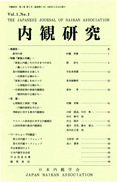Volume 22, Issue 1
Displaying 1-11 of 11 articles from this issue
- |<
- <
- 1
- >
- >|
OPENING REMARKS
-
2016 Volume 22 Issue 1 Pages 1
Published: September 15, 2016
Released on J-STAGE: December 26, 2020
Download PDF (923K)
THE RALLY CHAIRMAN'S LECTURE
-
2016 Volume 22 Issue 1 Pages 3-12
Published: September 15, 2016
Released on J-STAGE: December 26, 2020
Download PDF (1509K)
POINT OF CONTENTION
-
2016 Volume 22 Issue 1 Pages 13-21
Published: September 15, 2016
Released on J-STAGE: December 26, 2020
Download PDF (1182K) -
2016 Volume 22 Issue 1 Pages 23-25
Published: September 15, 2016
Released on J-STAGE: December 26, 2020
Download PDF (985K)
DISCUSSION
-
2016 Volume 22 Issue 1 Pages 27-35
Published: September 15, 2016
Released on J-STAGE: December 26, 2020
Download PDF (1090K)
ORIGINAL ARTICLES
-
2016 Volume 22 Issue 1 Pages 37-46
Published: September 15, 2016
Released on J-STAGE: December 26, 2020
Download PDF (1096K) -
2016 Volume 22 Issue 1 Pages 47-57
Published: September 15, 2016
Released on J-STAGE: December 26, 2020
Download PDF (1176K) -
2016 Volume 22 Issue 1 Pages 59-74
Published: September 15, 2016
Released on J-STAGE: December 26, 2020
Download PDF (2989K) -
2016 Volume 22 Issue 1 Pages 75-89
Published: September 15, 2016
Released on J-STAGE: December 26, 2020
Download PDF (1565K) -
2016 Volume 22 Issue 1 Pages 91-103
Published: September 15, 2016
Released on J-STAGE: December 26, 2020
Download PDF (1590K)
SHORT REPORT
-
2016 Volume 22 Issue 1 Pages 105-112
Published: September 15, 2016
Released on J-STAGE: December 26, 2020
Download PDF (996K)
- |<
- <
- 1
- >
- >|
